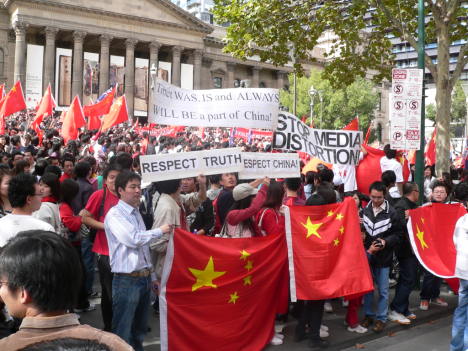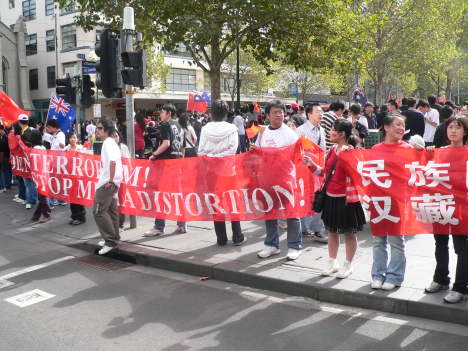Yesterday I came across a Chinese demonstration outside the State Library in Swanston Street, Melbourne, calling on Australians to support the Olympics in Beijing. The message was that the Western media has distorted the events surrounding Tibet. After all, the banners told us, Tibet was, is and always will be part of China.

It appears as though a large proportion of the Chinese people (Han) believe that Tibet always has been part of China. Clearly the history books don’t offer much insight into the complexity that is Tibet, let alone China as a whole. Tibet was ruled by local kings from the seventh to eleventh century AD. Tibet was invaded, like much of China, by Mongol rulers in 1240 AD. In the early 18th century AD Tibet came under the sovereignty of the Qing dynasty, with the Dalai Lamas taking a leadership role recognised by the Chinese.
In 1903 the British Empire, competing for supremacy with the growing Russian empire, invaded Tibet. Thousands of Tibetans were massacred by the British troops. The British and Russians signed treaties with China, recognising that Tibet was under Chinese sovereignty.

After the fall of the Qing dynasty in 1912 Tibet asserted a new independence from Chinese rule. It wasn’t until 1950 when troops of the People’s Republic of China invaded Tibet that the region once again came under the Chinese banner. The Seventeen Point Agreement for the Peaceful Liberation of Tibet, signed in Beijing in 1951 by representatives of Tibet and China, established a framework which would allow the Tibetan people the right of exercising national regional autonomy under the unified leadership of the Central People’s Government. The Dalai Lama was allowed his place in the leadership of Tibet, until a rebellion in 1959.
Simple campaigns with simple slogans do distort and diminish the portrayal of truth. Closer examination of the stories behind the stories reveals that more people are implicated in the flattening of history than we realise.

Tibet has been part of China since the Mongolian empire of the 13th century, actually before the Ireland and Scotland became part of UK. It is now an autonomous region of China and has received extensive modernisation and improvement in basic amenities such as education and hospitals. The Dalai Lama is not calling for Tibet to become independent, however a minority element has decided to use violence for their own political purposes. Both Tibetan and Han Chinese were impacted by the violence of this externally motivated minority with at least 13 innocent civilians burned or stabbed to death.
How many of the pro-Tibet independence people know the history of Tibet prior to 1950 and the treatment of the ordinary Tibetans by the religious elite prior to the Chinese government being formed? It is not the Tibetan people who are desperate, but the external forces that are behind the violent protests.
Hopefully our free Western media will show a more balanced portrayal of the issues backed by real investigative journalism.
Then United States is invaded also.
North America should be ruled by Indians.